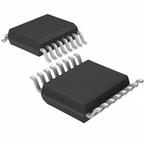Product Details
●The ADG5412/ADG5413 contain four independent single-pole/single-throw (SPST) switches. The ADG5412 switches turn on with Logic 1. The ADG5413 has two switches with digital control logic similar to that of the ADG5412; however, the logic is inverted on the other two switches. Each switch conducts equally well in both directions when on, and each switch has an input signal range that extends to the supplies. In the off condition, signal levels up to the supplies are blocked.
●The ADG5412 and ADG5413 do not have a VL pin. The digital inputs are compatible with 3 V logic inputs over the full operating supply range.
●The on-resistance profile is very flat over the full analog input range, which ensures good linearity and low distortion when switching audio signals. High switching speed also makes the devices suitable for video signal switching. The ADG5413 exhibits break-before-make switching action for use in multiplexer applications.
●Product Highlights
● 1. Trench isolation guards against latch-up. A dielectric trench separates the P and N channel transistors thereby preventing latch-up even under severe overvoltage conditions.
● 2. Low RON.
● 3. Dual-supply operation. For applications where the analog signal is bipolar, the ADG5412/ADG5413 can be operated from dual supplies up to ±22 V.
● 4. Single-supply operation. For applications where the analog signal is unipolar, the ADG5412/ADG5413 can be operated from a single rail power supply up to 40 V.
● 5. 3 V logic compatible digital inputs: VINH = 2.0 V, VINL = 0.8 V.
● 6. No VL logic power supply required.
●Applications
● Relay replacement
● Automatic test equipment
● Data acquisition
● Instrumentation
● Avionics
● Audio and video switching
● Communication systems
●### Features and Benefits
● Latch-up proof
● 8 kV human body model (HBM) ESD rating
● Low on resistance (<10 Ω)
● ±9 V to ±22 V dual-supply operation
● 9 V to 40 V single-supply operation
● 48 V supply maximum ratings
● Fully specified at ±15 V, ±20 V, +12 V, and +36 V
● VSS to VDD analog signal range


